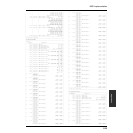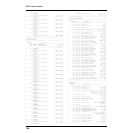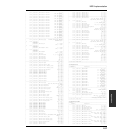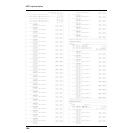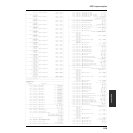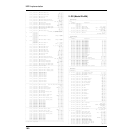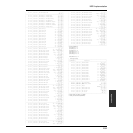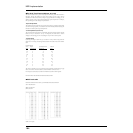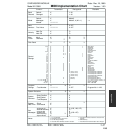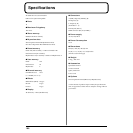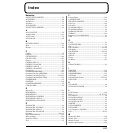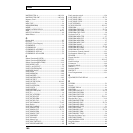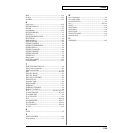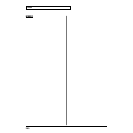
193
MIDI Implementation
Appendices
●Example of an Exclusive message and calculating a
checksum
Roland Exclusive messages (RQ1, DT1) are transmitted with a checksum at the end (before
F7) to make sure that the message was correctly received. The value of the checksum is
determined by the address and data (or size) of the transmitted Exclusive message.
❍How to calculate the checksum (hexadecimal numbers are indicated by
“H”)
The checksum is a value derived by adding the address, size, and checksum itself and
inverting the lower 7 bits.
Here's an example of how the checksum is calculated. We will assume that in the Exclusive
message we are transmitting, the address is aa bb cc ddH and the data or size is ee ffH.
aa + bb + cc + dd + ee + ff = sum
sum ÷ 128 = quotient ... remainder
128 - remainder = checksum
<Example 1> Setting CHORUS TYPE of PERFORMANCE COMMON to DELAY (DT1).
According to the “Parameter Address Map (p. 181),” the start address of Temporary
Performance is 10 00 00 00H, the offset address of CHORUS at PERFORMANCE COMMON
is 04 00H, and the address of CHORUS TYPE is 00 00H. Therefore the address of CHORUS
TYPE of PERFORMANCE COMMON is;
10 00 00 00H
04 00H
+) 00 00H
10 00 04 00H
DELAY has the value of 02H.
So the system exclusive message should be sent is;
F0 41 10 00 10 12 10 00 04 00 02 ?? F7
(1) (2) (3) (4) (5) address data checksum (6)
(1) Exclusive Status, (2) ID (Roland), (3) Device ID (17),
(4) Model ID (XV-3080), (5) Command ID (DT1), (6) End of Exclusive
Then calculate the checksum.
10H + 00H + 04H + 00H + 02H = 16 + 0 + 4 + 0 + 2 = 22 (sum)
22 (sum) ÷ 128 = 0 (quotient) ... 22 (remainder)
checksum = 128 - 22 (remainder) = 106 = 6AH
This means that F0 41 10 00 10 12 10 00 04 00 02 6A F7 is the message should be sent.
<Example 2> Getting the data (RQ1) of Performance Part 3 in USER:03.
According to the “Parameter Address Map (p. 181),” the start address of USER:03 is 20 02 00
00H, and the offset address of Performance Part 3 is 00 22 00H.
Therefore the start address of Performance Part 3 in USER:03 is;
20 02 00 00H
+) 00 22 00H
20 02 22 00H
As the size of Performance Part is 00 00 00 21H, the system exclusive message should be
sent is;
F0 41 10 00 10 11 20 02 22 00 00 00 00 21 ?? F7
(1) (2) (3) (4) (5) address data checksum (6)
(1) Exclusive Status, (2) ID (Roland), (3) Device ID (17),
(4) Model ID (XV-3080), (5) Command ID(RQ1), (6) End of Exclusive
Then calculate the checksum.
20H + 02H + 22H + 00H + 00H + 00H + 00H + 21H = 32 + 2 + 34 + 0 + 0 + 0 + 0 + 33 = 101
(sum)
101 (sum) ÷ 128 = 0 (quotient) ... 101 (remainder)
checksum = 128 - 101 (remainder) = 27 = 1BH
This means that F0 41 10 00 10 11 20 02 22 00 00 00 00 21 1B F7 is the message should be sent.
<Example 3> Getting Temporary Performance data (RQ1);
cf.) This operation is the same as Data Transfer function in Utility mode with “PERFORM”
(Type parameter) and “TEMP: -PATCH” (Source parameter) options.
According to the “Parameter Address Map (p. 181),” the start address of Temporary
Performance is assinged as following:
10 00 00 00H Temporary Performance Common
:
10 00 20 00H Temporary Performance Part 1
:
10 00 2F 00H Temporary Performance Part 16
As the data size of Performance Part is 00 00 00 21H, summation of the size and the start
address of Part 16 at Temporay Performance will be;
10 00 2F 00H
+) 00 00 00 21H
10 00 2F 21H
And the size that have to be got should be;
10 00 2F 21H
-) 10 00 00 00H
00 00 2F 21H
Therefore the system exclusive message should be sent is;
F0 41 10 00 10 11 10 00 00 00 00 00 2F 21 ?? F7
(1) (2) (3) (4) (5) address data checksum 6)
(1) Exclusive Status, (2) ID (Roland), (3) Device ID (17),
(4) Model ID (XV-3080), (5) Command ID (RQ1), (6) End of Exclusive
Calculating the checksum as shown in <Example 2>, we get a message of F0 41 10 01 10 11
10 00 00 00 00 00 2F 21 20 F7 to be transmitted.
<Example 4> Getting data (RQ1) at once;
Tempory Performance data,
Temporary Patch data of whole part in Performance mode,
Temporary Rhythm data of whole part in Performance mode.
cf.) This operation is the same as Data Transfer function in Utility mode with “PERFORM”
(Type parameter) and “TEMP: +PATCH” (Source parameter) options.
According to the “Parameter Address Map (p. 181),” the start address of the above all
parameters is assinged as following:
10 00 00 00H Temporary Performance
11 20 00 00H Temporary Patch (Performance Mode Part 1)
11 30 00 00H Temporary Rhythm (Performance Mode Part 1)
:
14 60 00 00H Temporary Patch (Performance Mode Part 16)
14 70 00 00H Temporary Rhythm (Performance Mode Part 16)
The offset address of Rhythm is also assigned as follows:
00 00 00H Rhythm Common
:
00 10 00H Rhythm Tone 1
:
01 3E 00H Rhythm Tone 4
As the data size of Rhythm Tone is 00 00 01 41H, summation of the size and the start
address of Tone 4 of Part 16 at Temporay Patch in Performance mode will be;
14 70 00 00H
01 3E 00H
+) 00 00 01 41H
14 71 3F 41H
And the size that have to be got should be;
14 71 3F 41H
-) 10 00 00 00H
04 71 3F 41H
Therefore the system exclusive message should be sent is;
F0 41 10 00 10 11 10 00 00 00 04 71 3F 41 ?? F7
(1) (2) (3) (4) (5) address data checksum (6)
(1) Exclusive Status, (2) ID (Roland), (3) Device ID (17),
(4) Model ID (XV-3080), (5) Command ID (RQ1), (6) End of Exclusive
Calculating the checksum as shown in <Example 2>, we get a message of F0 41 10 00 10 11
10 00 00 00 04 71 3F 41 7B F7 to be transmitted.



